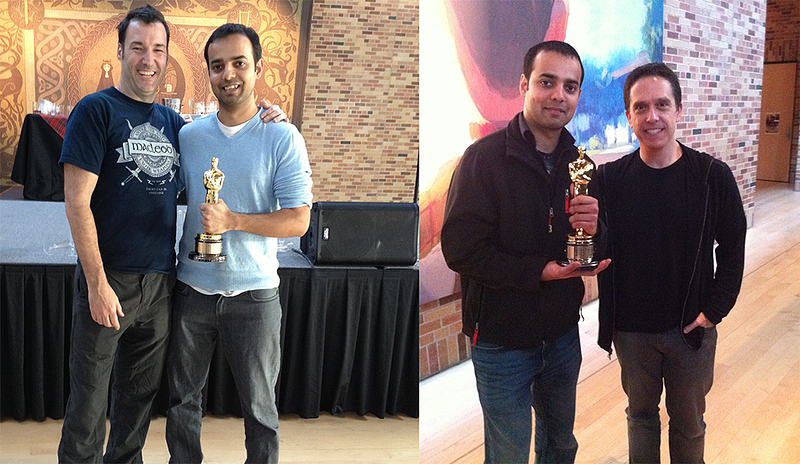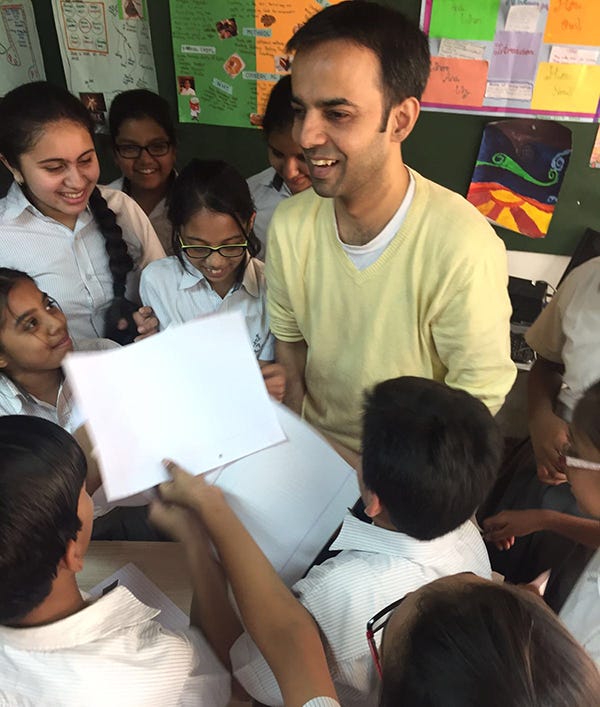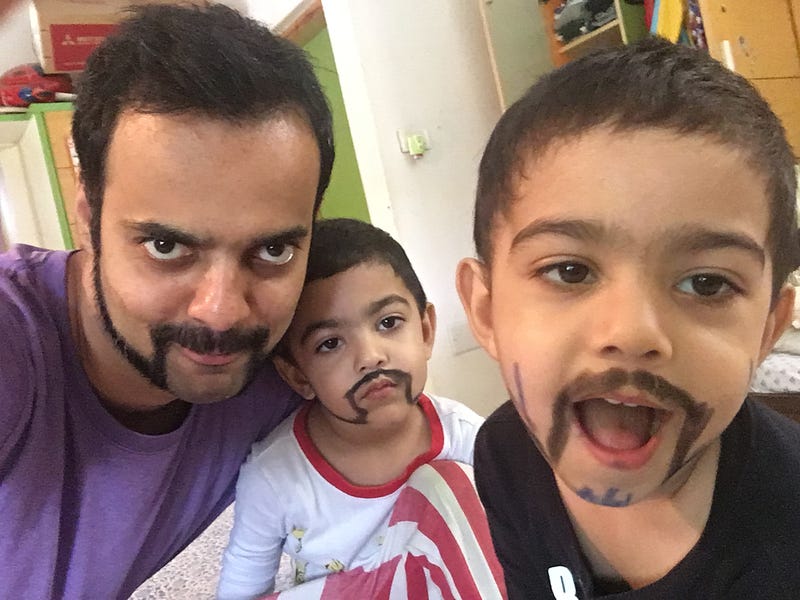Trending
Opinion: How will Project 2025 impact game developers?
The Heritage Foundation's manifesto for the possible next administration could do great harm to many, including large portions of the game development community.

Featured Blog | This community-written post highlights the best of what the game industry has to offer. Read more like it on the Game Developer Blogs or learn how to Submit Your Own Blog Post
A career retrospective with 3 things learned per each job I've had in the past 12 years - Electronic Arts, Pixar, Lumosity, Teal Labs and Masala Games.

I will try to keep it brief, lest this become a book! (eh, publishers?)
I hope this encourages others to share a “3-things…” post. It’s fun to introspect and accumulate learnings from your career. But first, a shiny picture of some films I’ve worked on!

Why 3 things? It’s something Randy Pausch asked us to do after each project at Carnegie Mellon’s Entertainment Technology Center. “List 3 things that worked, 3 things that didn’t and 3 things you’ll do differently next time”. I’m modifying Randy’s thought exercise a bit to bring you 3 things I learned per each job I’ve had in my career so far. Let’s begin.
Software Engineer, 2005–2009

The Spore team hitting “First Internal Playable”. I am towards the top left
In 2005, I joined Maxis straight out of grad school at Carnegie Mellon to work on Will Wright’s game “Spore”. I was part of the core engine team.
My career has been about building tools for creative people. Tools for gamers to create their own universe (Spore), tools for professional artists to craft beautiful characters (Pixar), tools for education (Teal Labs) etc. Early on, I learned that the most important thing is to get your own tools right. Evaluate and improve your workflow constantly. Huge thanks to @AndrewWillmott for being an amazing mentor who showed me this and so much more. Which brings us to…
People who think deeply but communicate simply tend to be good mentors. Other kinds of mentors guide you through their work, instead of their words. Regardless of their style, good mentors make all the difference. While receiving mentorship is key early on, paying it back by guiding others is equally rewarding later in your career.
I learned a lot from the production cycle of Spore because we got one half of the product right and the other half wrong. The Creature Editor in Spore is a great example of investing tremendously in a product till it’s ready. The game part of Spore, however, was presented too early (and too well). Then, the longer we took to finish it, the more deadline-oriented it got. Ultimately quality suffered. My learning: Deadlines should be kept simple — show something in private user tests every X weeks. Then focus on scope and quality and do a public beta when it’s ready leading up to product release.
Shading Technical Director, 2009–2014

One of the many soft perks at Pixar. Oscar pictures with the directors! Mark Andrews (left) and Lee Unkrich (right)
In 2009 I joined Pixar after a rather grueling interview process. I was put in charge of a 16 year old application, written in an obscure programming language. 50 artists hated it but used it as their primary tool to shade all the characters and sets on all the movies in production. No engineers wanted to work on this thing. Welcome to Pixar!
Having a reasonable portfolio of work displayed on my website has opened doors for me time and again. My Pixar interviews went terribly. Most of the team didn’t think I had the chops for the job. But the leader of the engineering group — Bill Polson had seen my website. Apparently he was the only one who had. So he called everyone into a room, put the site up on the screen and said “This guy has done more computer graphics than a lot of you in this room combined” — he was exaggerating, but his point was well taken and I got a shot! A few months into the job, a number of folks came by and told me the story of how they had rejected me in interviews but were very glad to be wrong. Phew!
Don’t just sit in your own chair. Visit people in departments downstream or upstream from yours and try to do their job. If you become your client you will be able to deploy your vision as if it was the client’s idea all along. At Pixar, I was able to reform the entire shading pipeline across a period of 2 years while 50 artists used it daily without disruption. Like any good method actor I took it too far and eventually gave up my software engineer role to become a shading artist working on characters and sets using the tool I once maintained.
I feel the most fulfilled when I’m learning tons of new stuff. Bill Polson once said to me — “If you’re going to work somewhere for 5 years, make sure it’s not the same year repeated 5 times”. I live by that. You don’t need to “be an artist” to make good art or “be a programmer” to develop great software. Put your ego away and try new things. I went from being a tools engineer to a character and sets artist at Pixar. The transitions were tough and not necessarily smart career moves but the personal growth was immense.
I learned so many amazing things at Pixar that I could write a book. Luckily my hero and Pixar president Ed Catmull already did — Read Creativity Inc.
Senior Software Engineer, 2014–2016

Lumos Labs is based in this historic San Francisco building. I took this picture on one of our daily bubble-tea breaks.
In grad school, I co-founded the Experimental Gameplay Project (EGP). We made 50 game prototypes in one semester and had the best time ever. I was always looking for a job version of the EGP. In 2014, I discovered Lumosity and immediately wanted to work there EGP-style.
This learning is for interviewers and managers trying to hire candidates that are a great fit. Lumos Labs sent me a design document and asked me to build a game using only HTML and JS. I had about 6–8 hours to do it. During in-person interviews I was asked to make lots of modifications to my game. They do similar tests for all the roles they hire for. Build something, then modify and defend it — so much more effective than typical interviews!
Lumosity prides itself on the scientific research they put into their games. I can tell you it’s not a marketing gimmick, though the FTC thought so. At Lumos they take the science stuff so seriously that we could barely get any games approved by the Science Team. This was a problem because our customers wanted more games, different kinds of games and were using the product to have fun. Whether games make you smart or not, the truth is people practice because it feels good to work out your brain. And in my opinion, by not providing lots of new stuff regularly, we lost a lot of players to the competition. Sometimes we make the mistake of implicitly following what has worked before and get too close to our ethos to challenge it.
To me, Lumosity’s greatest achievement is showing that a subscription based product made entirely out of mini-games can be a huge success. When a number of small projects serve a common theme they can really turn into something very deep and meaningful even if each project itself is relatively shallow. As a fan of quick and small projects, this gives me great hope.
Chief Technology Officer, 2016

Getting mobbed by kids!
I’ve always been very interested in educational technology. So I spent 2016 working closely with a K-12 school. My team and I deployed iPads for 350 students and 5o teachers, created custom apps and came away with tons of learnings about learning itself!
At Teal Labs I insisted that our office be inside the school we were working with. So we sat in a room behind the library where we welcomed invasions by kids during recess. I also made it compulsory for my team to take classes or co-teach at least once a week. This helped us make relevant and engaging products and improve upon them in a tight feedback loop.
We invest so much in giving fantastic content to students on a plate. They eat it up voraciously, but it doesn’t translate into skills and knowledge. It just turns kids into content-addicts expecting easy content all the time. On the other hand, if a child is asked to research and teach a topic or create a report on it, the retention of learning is much higher. Teaching is the best learning, as they say. My Teal Labs experience taught me that educational technology should be about engaging tools for students to create, teach, perform and present. Then, as Will Wright would say, “get out of the way and watch them go!”. “Tools to produce content” is also the answer to — What role should VR/AR have in education?
The best learning experiences are so fun, that you lose track of time. The best entertainment experiences are so transformative that you end up growing and learning something about yourself. Engagement is a key ingredient to both education and entertainment. In the classroom we found that engagement comes from meaningful social interactions with other students- discussions, performances, collaboration and competition. We built an asynchronous multiplayer game for 350 students. The game was about capturing territory in a common world by doing math problems. Each student collaborated with everyone in her class but competed with students from other classes. We saw 40x more participation in math as a result!
Director, Developer, Janitor, (side project since 2012, For reals in 2017)

I have no idea what I’m doing, but it’s fun
After being lulled by the sweet embrace of gainful employment for 12 years, I finally made the jump into full time independent development. I am making my own games right now because it’s my favorite thing to do and I want my kids to grow up and play 10 awesome things that their papa made.
Being your own boss is the best! There is nothing more exhilarating than people buying and appreciating a product that is all your own. But there is nothing more depressing than not being able to reach those people. My first game Word Mess has 603,143 downloads (in 5 years) and I have cheered each one of them like I cheered Toy Story 3 winning an Oscar. My recent app Text Mess, on the other hand, has only been downloaded a 100 times in its first 10 days and I feel like jumping off of a bridge :P Hopefully I can learn to trust the process and be cooler about the ups and downs.
You can succeed without any major risks if you plan smartly, execute patiently and course correct regularly. It comes down to how you calculate risk and define success. Success for me is financial independence and 100% ownership of my work. To me, risk is when uncertainty can’t be bounded within a small ok-to-fail region of tolerance. In other words, I don’t like risk :) That’s why I’ve patiently saved and learned for 12 years before venturing out on my own. What do risk and success mean to you?
You are too close to your work. Find a good bullshit detector who will tell you like it is. Ideally, they are also part of (or understand) your target audience. In my case, my wife usually plays this role. She is brutally honest (sometimes too brutal) about the stuff I make. Build a group of early-feedback providers like it’s Pixar’s Brain Trust.
Invest in your own tools
Seek a good mentor, be a good mentor
“When it’s ready” is the best deadline
Document your journey
Eat your own dog food
Do different things, don’t be afraid to start from zero
Separate makers from fakers
Challenge your ethos
The whole can be greater than sum of its parts
Surround yourself with your audience
Give students tools to produce content
Education and Entertainment are the same thing
Business is a crazy emotional roller-coaster
Clearly define what risk and success mean to you
Find a good bouncing wall
There you have it! Learnings from a colorful decade or so of career. I am incredibly thankful to my mentors, coworkers and friends for this amazing journey. I hope #4 encourages you to make your own 3-things post. If you do, send it to me-

Random picture of my boys and I rocking mutton chops
Read more about:
Featured BlogsYou May Also Like